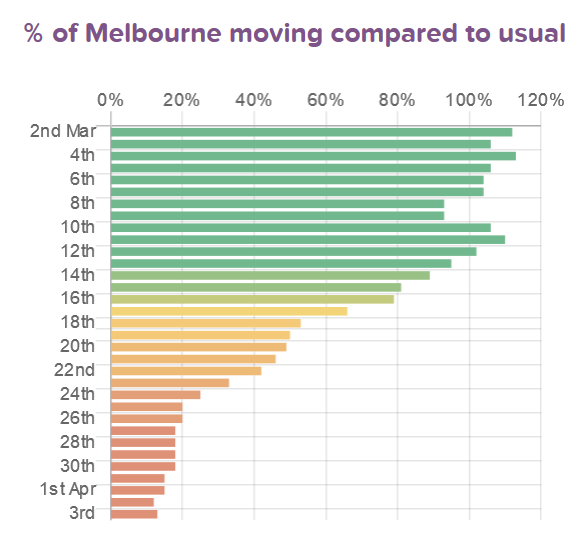While governments overseas have been looking to mobile network operators to assist in measuring reductions in social movement, Australia had – until most recently, it seems – avoided doing the same thing.
However, Ben Grubb at the Sydney Morning Herald reports this morning that “Vodafone has provided the mobile phone location data of several million Australians in an anonymised and aggregated form” to the NSW and federal governments, to allow those governments to ascertain whether people are following social distancing and “stay at home” directives.
Prior to this, governments had access to some fairly high level information; just this week, Google published information on a state-by-state basis showing a reduction in movement and attendance at certain types of venue (e.g. workplaces, transport hubs, areas of recreation, etc). However, that information is quite broad.
Apps like CityMapper, too, have shown how people move through populous areas like Sydney and Melbourne, and that data also shows a slowing of movement and – unsurprisingly – more people just staying put at home. Take, for example, this graph showing movement in Melbourne over the last month:

However, what if you’re a government looking for more information which is a little more precise? Well, records from one of our major telcos would help provide that kind of detail, even if it is provided in an anomymised fashion.
In a statement given to Ausdroid this morning, Vodafone’s Director of External Affairs Dan Lloyd said that:
“VHA has provided, on request, aggregated network information to the NSW Department of Customer Service and the federal Department of Prime Minister and Cabinet”
The data – which we’ve not seen, but from what we understand – shows the number of Vodafone customers in particular areas at particular times. From that data, it would be possible to ascertain that:
- On a given date prior to COVID-19 restrictions, x number of users were in an area at a given time, and at a later time of day, there were y number of users. This might show, for example, a large number of users in the Sydney CBD during business hours, and a reducing number into the evening.
- Equally, the number of users in suburban areas – primarily residential – may reduce during that same timeframe, when such users were at their regular places of work.
- Post COVID-19 restrictions, Vodafone’s data may show that the growth of users in CBD areas has shrunk, and the volume of users in residential areas overnight may have shrunk less than normal, indicating – perhaps – that most users were staying at home, or at least in their local areas.
Vodafone has been clear that it has not provided personally identifiable information, though it has provided data garnered from its (roughly) 6 million customers and their movements according to their phones’ registration against the company’s cell towers.
If the data is as Vodafone has claimed, then it would be extraordinarily difficult to glean any personally identifiable information from it. As a whole, the data is said to show certain trends in movement only – of the kind shown by CityMapper above, for example – but likely in greater detail (perhaps down to the individual cell-tower / service area).
Grubb also sought comment from Telstra and Optus, with both opting not to say whether they had also provided data to government in this form.
For the full report, head over to the Sydney Morning Herald.





SA Police used a phone tracking system back in early February to track the movements of two people infected with coronavirus.
https://www.abc.net.au/news/2020-02-06/phone-tracking-follows-movements-of-couple-with-coronavirus/11935912